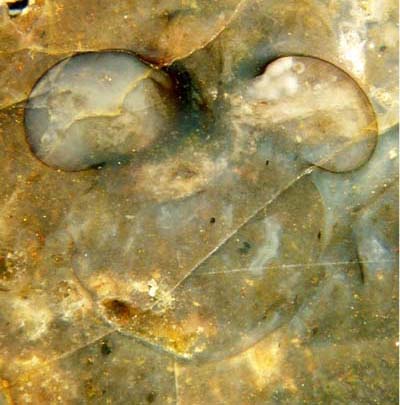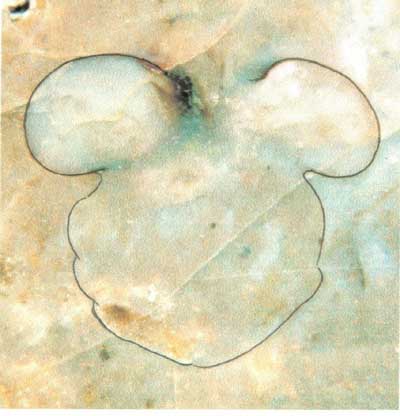What did Castracollis
look like ?
Since the formation of the Rhynie chert was facilitated by flooding
with silica-enriched water, it was no big surprise when a
water-dwelling creature was found among terrestrial vegetation
[1]. One can only wonder why it took more than 70 years to
discover other crustaceans in the chert [2,3]. (See also Rhynie
Chert News 12.
)
One of the recently discovered species,
Castracollis
[2] (which is the Latin equivalent of Castlehill, a farm near
Rhynie), has been regarded as "one of the most important recent
discoveries that bear on the elucidation of branchiopod evolution" [4].
Its tentative reconstruction in [2] involving a hypothetical carapace (shield) is based on
only one lump of chert, hence any new finds deserve attention since they may
show other details.
A piece of chert found in 2003 revealed several specimens of
Castracollis
on the surface and on cut faces, among them the one seen
below as a cross-section of the anterior part of the body. As a
conspicuous feature, what seems to be the carapace is divided into two
bulging halves, which does not fit to the reconstruction
proposed in [2], see Fig.3.
This lack of compatibility is presently being considered
by D. Waloszek
at Ulm University. Eventually the present find will lead
to a slightly modified reconstruction of this lately discovered
crustacean.


Figs.1,2: Castracollis,
cross-section of
the anterior part of the body
with bulging halves of a divided carapace,
width 3.2mm, contours outlined.

Fig.3: Reconstruction of Castracollis
wilsonae in [2]
with hypothetical carapace based on inconclusive
fossil evidence.
H.-J.
Weiss 2008, updated 2011
[1] D.J. Scourfield: On a new type of crustacean ...
Lepidocaris rhyniensis
...
Phil. Trans. Roy. Soc. London
(Series
B), 214(1926), 153-187.
[2] S.R. Fayers,
N.H. Trewin: A new crustacean from the Early
Devonian Rhynie Chert ...
Trans.Roy. Soc. Edinburgh,
Earth Sci.
93(2003), 355-382.
[3] L.
Anderson, W.R.B. Crighton, H. Hass: A new univalve
crustacean from the Early Devonian Rhynie chert
hot-spring complex,
Trans.Roy. Soc. Edinburgh, Earth Sci.
94(2004 for 2003), 355-369.
[4] J. Olesen: Monophyly and phylogeny of branchiopoda, with focus on morphology and homologies of branchiopod phyllopodous limbs,
J. Crustacean Biol. 27(2007), 165-183.
 |
 |
24 |






